What are the implications of Southern dirt for the soul of man? At 5:28 p.m., Oct. 23, Ashon Crawley answered this question in one of the Nasher's small lecture halls. The room was filled mostly with academics and friends — save for the stray Focus group — of Ashon Crawley (Graduate School ‘13), this year’s Nannerl O. Keohane Distinguished Visiting Professor.
Dr. Crawley is a Professor of Religious Studies and African American & African Studies at the University of Virginia. There he studies a number of topics, including black studies, theology and performance studies.
Dr. Crawley’s interdisciplinary studies complement the focus of this year’s Keohane Professorship: “Otherwise, We are Down South Folk — Dirt, Water, Air.” The professorship is designed to foster a scholarly relationship between Duke and UNC through a three-part lecture series that promotes intellectual life and conversation. Crawley is focusing his on the relation of soil to Black life and how its degradation directly diminishes Black possibility.
“Our lives have been severed from a sense of rootedness in place, and I acutely wish for place,” Crawley said. “I want to smell the earth and dirt and water. I want to hear it. I want slowness. I want a rhythmic form and a rhythmic pulse for life. I want to be immersed in it.”
The overarching theme of this presentation was structure as a mechanism for connectivity. Ironically, the N.J. native introduced this through Kintsugi, the Japanese art of breaking then repairing a preexisting item. For Crawley, Kinstugi allows him to examine the systems that comprise life, through dissection and creation, providing the lens through which he understands the world and his purpose within it. He connected this practice to his experience in the Pentecostal Church:
“[The Pentecostals] rip apart expectation and doctrinal integrity for what is considered good theological reflection, and instead they dance, they shout, they holler, they moan, they speak in tongues,” Crawley said.
This dismantling of the norm leaves room for new relationships — structures — to form among people. Crawley took care throughout the speech to highlight the importance of nurturing connection through music in art.
Though Crawley is no longer a part of the Pentecostal Church, having become an agnostic, the music and mysticism of the church is still an important part of his psychology.
“There's a dynamism to the built environment, the way it has to be imagined, the way repetition is necessary for buildings to emerge that are akin to music,” Crawley said to which hums responded. “The people in the congregation posture their flesh within the sound's context.”
Experimenting with this idea, Crawley created the “Yes! Lord Project” in 2020. The project comprised a group of singers repeating improvised “yes”’s and “yes, Lord”’s over Steven Reich’s highly repetitive “Music for 18 Musicians” for nearly an hour. The combination of repetition and improvised motifs signifies landscape for Crawley.
“Images of trees and bushes and grass, of lazy rivers and waterfalls, static, frozen, imagined futures'…'Consider the relationship between landform and gardener. This is a practice of improvisation, of being between things that grow and change and have life,” he said.
And so then music and art give way to landscape — the abstract landscape of a person, of a people, of systems interlocking. But if life is an amalgamation of systems, how do we interrogate the broken cogs created by injustice?
Crawley confronted his relationship to the American south as someone from the north whose opinion was dominated by notions of backwardness. He had to reconcile the spiritual necessity of the southern environment and culture with the violently complex history of slavery and current ecological disparity.
Concerning ecological disparity, Crawley focused heavily on Louisiana's Cancer Alley. This 85-mile stretch of the Mississippi River has around 200 fossil fuel and petrochemical operations that release billions of pounds of pollution into the soil, air and waterways. With high rates of maternal, fetal, cancer and respiratory issues — to name a few — the predominantly black population living along this toxic stretch suffers disproportionate effects from negligent pollution.
“We can barely smell the freshness of the earth for all that is being done to it in the name of industry, financialization and capitalist production,” Crawley said.
For the professor, the solution is more than simple, though important, awareness of these issues. On an individual level, he encourages a mystical exploration of one’s relationship with the natural world.
But it is more than remembering to smell the roses — relearning a connection with nature requires a dissolution of self into landscape. In a very Marilyn Robinson “unhouse me of this flesh” way, Dr. Crawley is asking us to go beyond the urban furnishings of life. Let nature pry your house apart and let the cold sink into your bones. There is a connection there, embrace it.
It was easy to get lost in the poetics of this lecture, and then suddenly realize that you had been cradled by rhythm to a precipice not fully understood. As spiritually valuable as the lecture was, some of the content had hazy relevance to the titular purpose of environmental justice.
The professor took his audience on a fascinatingly intricate journey structured in life, yet it functioned more as an introduction to his work than a fully coherent lecture. A lot of the content was so densely packed into the syntax and diction that it might have been better to read and dissect rather than listen to once.
The next two lectures in the series take place in January and April. Hopefully they will more concretely connect the themes of art, music and environmental justice. Attendance is recommended for this exciting series.
Get The Chronicle straight to your inbox
Sign up for our weekly newsletter. Cancel at any time.

